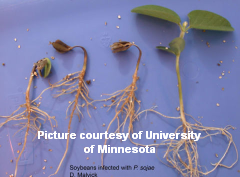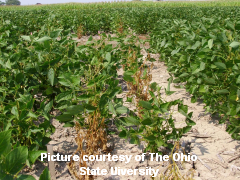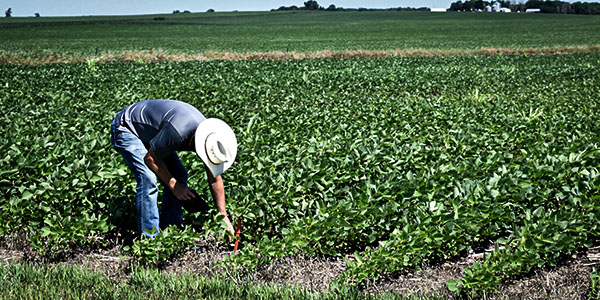AGRONOMICSUPPORT
YOU CAN TAKETO THE FIELD
Phytophthora Resistance vs Tolerance
Every spring in Ohio I receive many phone calls to evaluate soybean fields early in the growing season, and more times than not its related to Phytophthora Root Rot (PRR). Phytophthora Root Rot is one of the most devastating diseases our soybean farmers in Ohio face every year. It’s easy to become frustrated when dealing with this problem, as many times seed treatments are used, but the issue persists. Farmers will also select varieties with Phytophthora Rps resistance genes and still have issues. Naturally, they wonder why they still have problems and how to fix it.
First, it is important to understand what Phytophthora is, and what conditions are favorable. Phytophthora is caused by the pathogen Phytophthora sojae which is a fugal water mold that infects the plant and can survive in the soil upwards of 10 years. Plants can become infected anytime from germination through the growing season. Many times, symptoms are shown early and shortly after emergence, although I have seen symptoms into the summer. Major factors that increase probability of Phytophthora include, but are not limited to, poorly drained soils with high clay content, no-till and reduced tillage, and saturated soils from large rainfall accumulations. Most farmers in Ohio experience least one, if not all three, of those factors.
Phytophthora is something I am sure almost all of us have seen at some point in time. Seedlings die off early when infected early. The stems become soft and discolored while the roots are rotted. Plants may show symptoms even late in the year. The plants will have little to no vigor, and stems will be soft or brown. The leaves of the plant will yellow and die from the bottom up.


Solving this issue is the next step. Seed treatments are one of the easy things a farmer can do to protect their investment. If you’re not using one of LG Seeds AgriShield Treatment options, and the soybeans are treated downstream, make sure the treatment protects the seed against Phytophthora. Seed treatments have proven to help with the early season issues, but more is needed for season-long control. To best fight this disease seed treatment must be used on the right variety.
When it comes to choosing a variety to fight this yield-robbing disease, it is common to think that you need a variety that has a Rps gene for Phytophthora resistance, but in almost all cases this isn’t enough. Dr. Anne Dorrance, Department of Plant Pathology at The Ohio State University has done a lot of research on Phytophthora. Dr. Anne Dorrance’s studies have showed over 200 different pathotypes of Phytophthora sojae in Ohio soils and as many as 50 in a single field. If you look at soybean varieties almost all of them have a Phytophthora race resistance gene such as Rps1k, Rps1a, or Rps1c. So, if your soybean variety has race resistance to Rps1k it may protect you from specific races, if the Phytophthora hasn’t become resistant. Dr. Anne Dorrance’s study found that a single race resistant variety such as Rps1k, Rps1c, and Rps3a would only protect 50 percent of the field.
Therefore, field tolerance has become increasingly important. Being a member of the LG Seeds Soybean Pre-Commercial Research team, one of the first factors I look at is not what race does the variety have, but what is its field tolerance. While genes such as Rps1k and others are great, if the plant doesn’t have good field tolerance, there will likely be issues with that variety. Also, with there being so many races present in almost all our fields in Ohio, one or even two genes aren’t going to be enough. Tolerance paired with a Race Resistance will greatly improve your odds of having a successful soybean crop.
I can’t stress enough how major of a problem Phytophthora Root Rot is for soybean farmers. Make sure you’re doing everything you can to protect your seed investment. Use a good high-quality seed treatment such AgriShield from LG Seeds and choose a variety that has great field tolerance. If the variety has a specific gene for Phytophthora race resistance, that’s a plus but remember almost every field will have more than just the race the variety has a gene to protect against.
If you’d like help finding a soybean variety with the agronomic package you need, contact your local LG Seeds Technical Team Agronomist. Thanks for reading and supporting LG Seeds. I hope everyone has a safe spring!
Download a copy of this technical bulletin here: Phytophthora Resistance vs Tolerance
References and Additional Information






Technical Team Agronomist